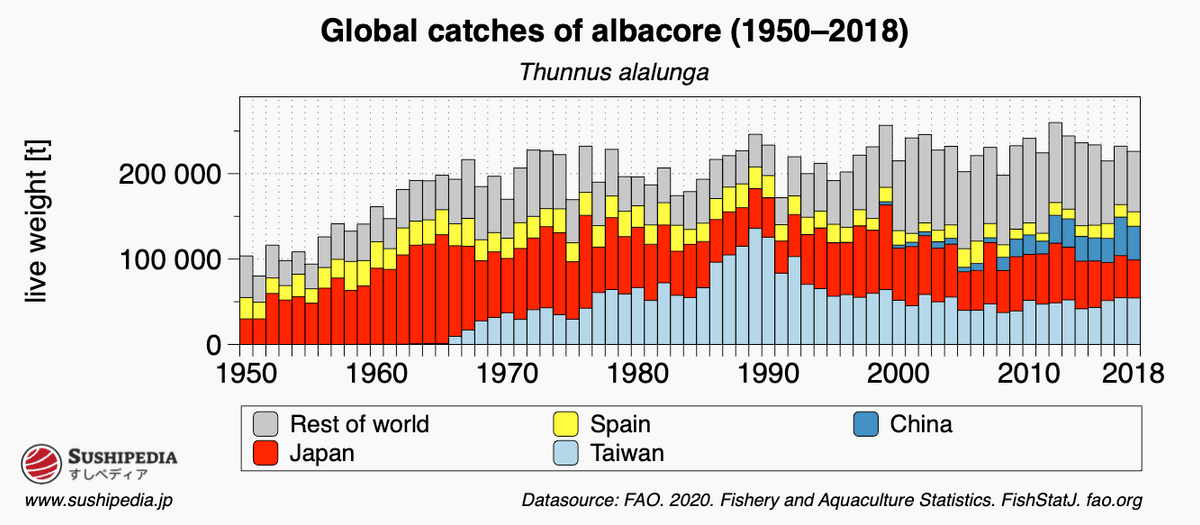Binnaga (Binchou) Sushi
Albacore
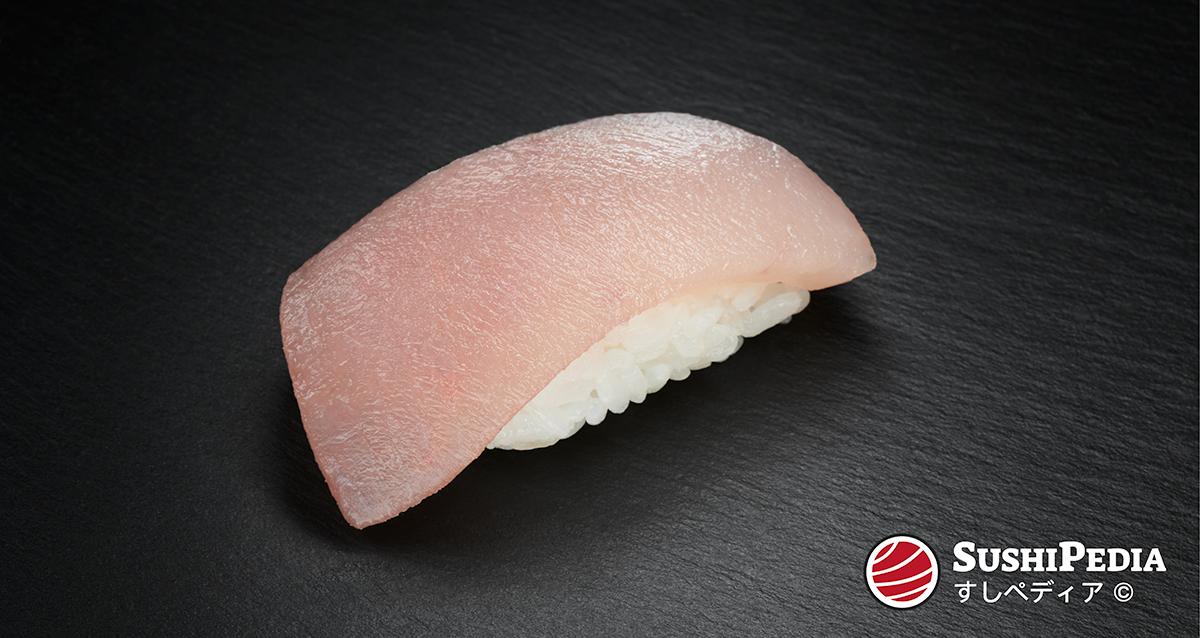
What is Binnaga (Binchou) (Albacore)?
In Japanese, albacore tuna is called binnaga, binchou or with reference to the meat used, bintoro. It is a relatively small species of tuna (maguro). Binnaga is considered a valuable edible fish and is of great economic importance. In recent years, his meat has become increasingly popular for making sushi or sashimi even outside Japan.
Binnaga (Binchou) as Ingredient for Sushi or Sashimi
For sushi and sashimi, mainly individuals caught in cold regions are suitable. In contrast to specimens from warmer regions, these have a significantly higher fat content. The fat meat of these fish is called bintoro, occasionally the term is also used for whole specimens from cold regions. Albacore tuna (binnaga) from warm waters, on the other hand, lack the necessary fat content to produce a full-bodied umami flavor. The fatty meat is tasty and preferred for the preparation of sushi and sashimi. The lean red meat (akami, あかみ), on the other hand, is less appealing and is rarely used as an ingredient for sushi or sashimi.
The remarkably bright, fatty meat is slightly sweetish, barely sour, very tender and melts well on the tongue. A common method of preparation is the tataki method (たたき), in which the meat is heated briefly and then quenched with ice water. This keeps the meat inside still raw, the texture gains firmness and its taste becomes more aromatic. The meat of the albacore tuna (binnaga) should be light in color, from white-pink to deep pink and should not show any bloodstains or bruises.
Compared to other tunas, albacore tuna (binnaga) is much cheaper, milder in taste, paler in color and less firm. It is usually found fresh, smoked or processed as high quality canned fish. It is one of the most economically significant edible fish of our time and is considered a popular main ingredient or side dish in many dishes worldwide. Albacore tuna (binnaga) is regularly used as a filling for Japanese rice balls (onigiri, お握り) which are offered in Japanese convenience stores (konbini, コンビニ). Handformed sushi (binnaga nigirizushi) or sashimi is a popular ingredient in cheap sushi restaurants, supermarkets and conveyor belt sushi restaurants (kaitenzushi, 回転寿司).
Best Season
Albacore tuna (binnaga) sushi or sashimi is a popular winter dish. Due to the global spread and good logistical availability, the fish is also available all year round in good quality.
Characteristics & Ecology of Binnaga (Binchou) (Albacore)
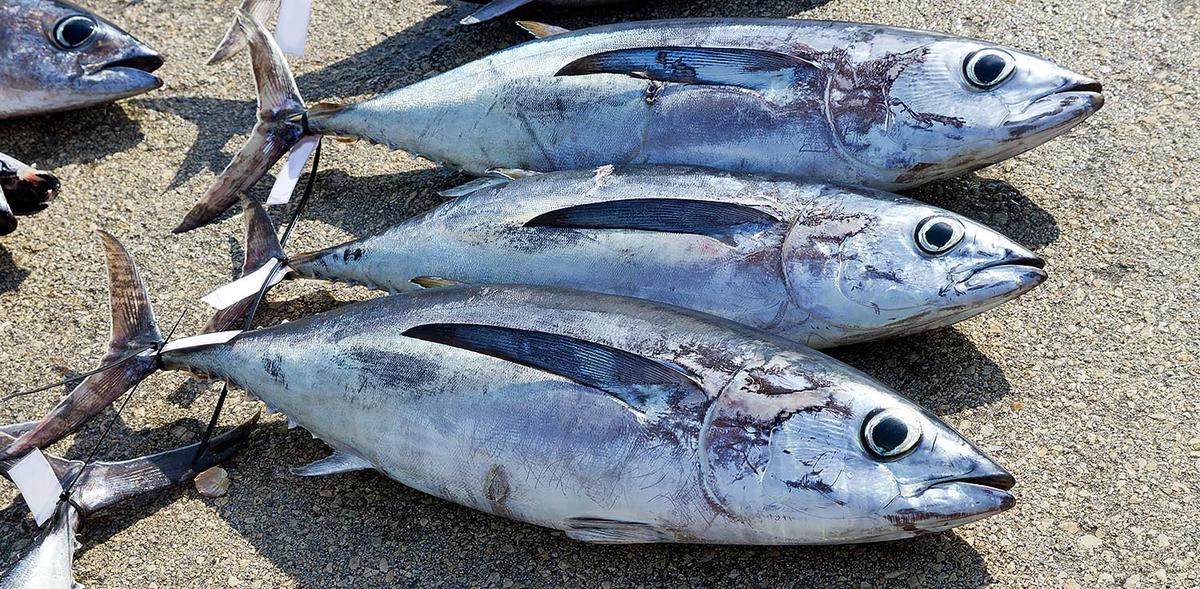
Adult albacore tuna (binnaga) reach a total length of 140 cm and weigh 60 kg. However, most landed fish have a size of 50 to 100 cm. Binnaga is a worldwide common deep-sea fish, which is mainly found in the upper and middle layers of water and penetrates in depths of at least 380 meters in the Pacific and up to 600 meters in the Atlantic. They cover very large distances and form groups with other conspecifics of the same age. Its preferred water-temperature is between approximately 16 and 20°C. As a predatory fish, it feeds on a wide range of smaller schooling fish, crustaceans and squid.
Economy
Gallery
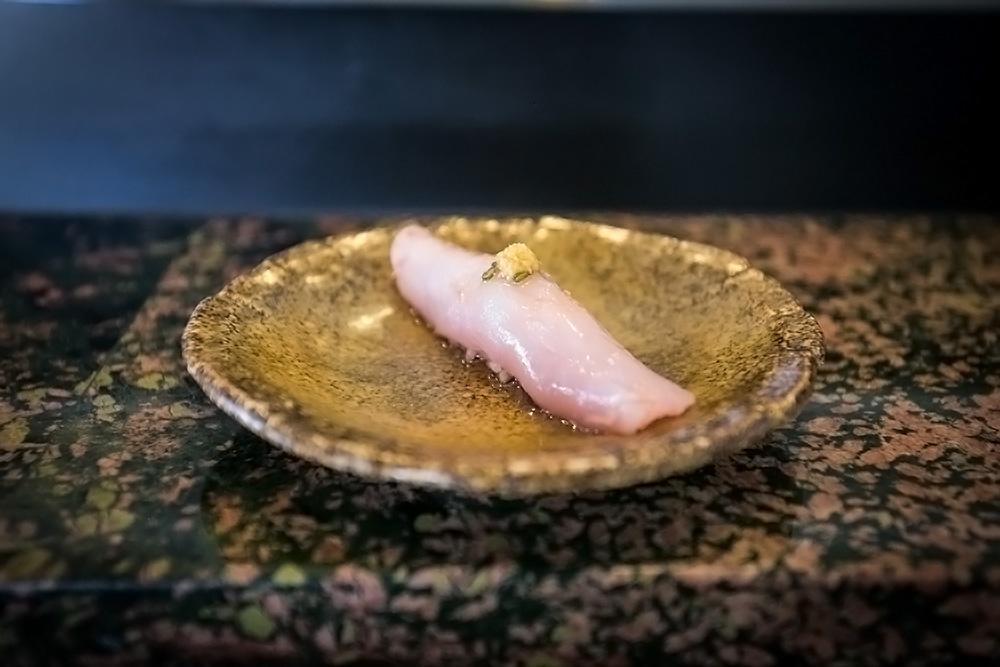
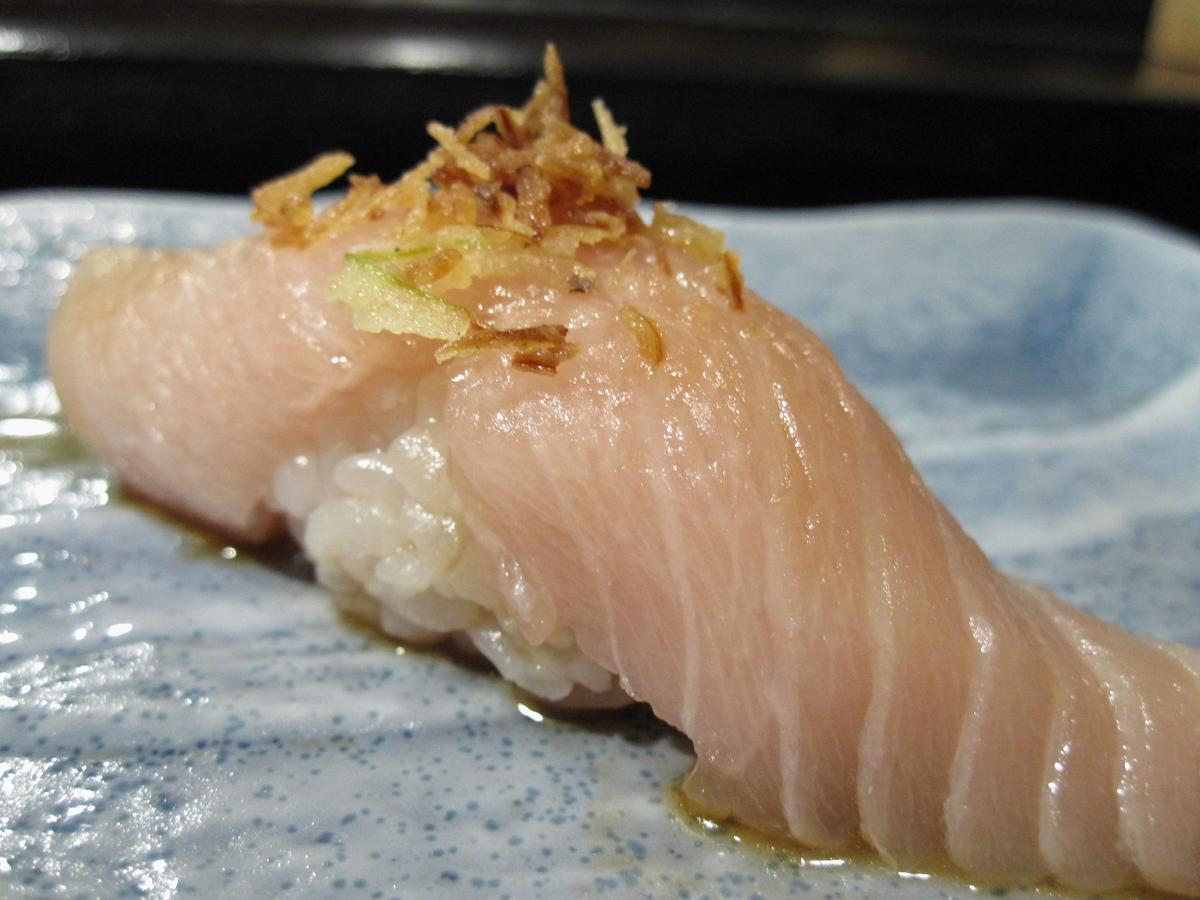
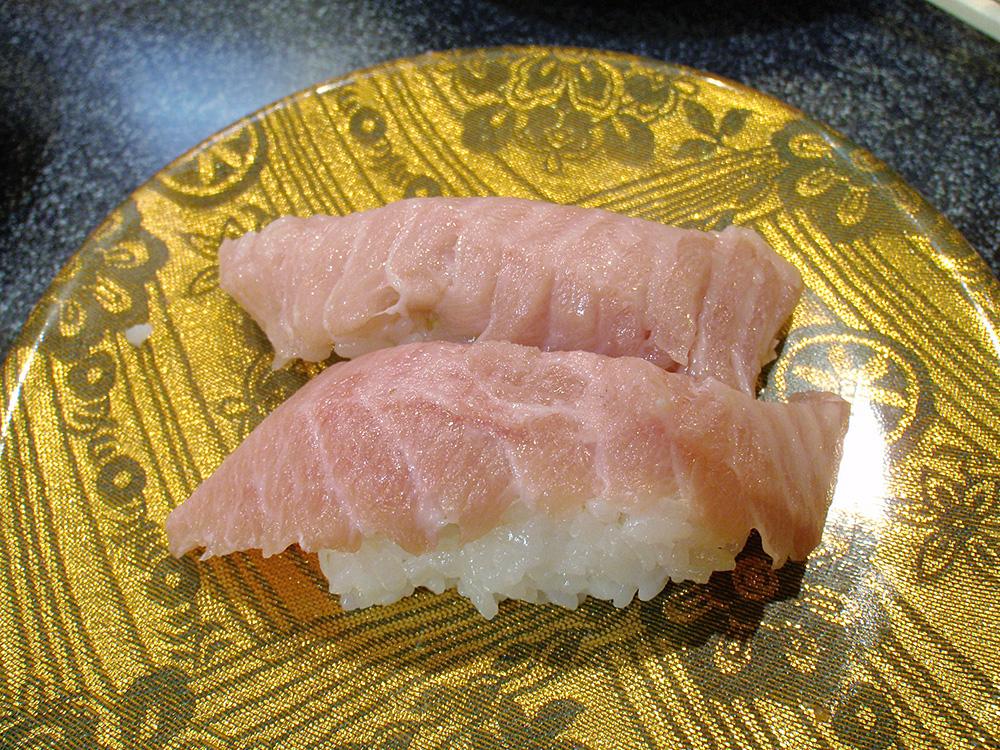
Further information on the author can be found in the section on image credits.
Video about Binnaga (Binchou)
External video embedded from youTube.com: k harata. 南紀・那智勝浦浦島での鬢長マグロ解体
Distribution Area of Binnaga (Binchou)
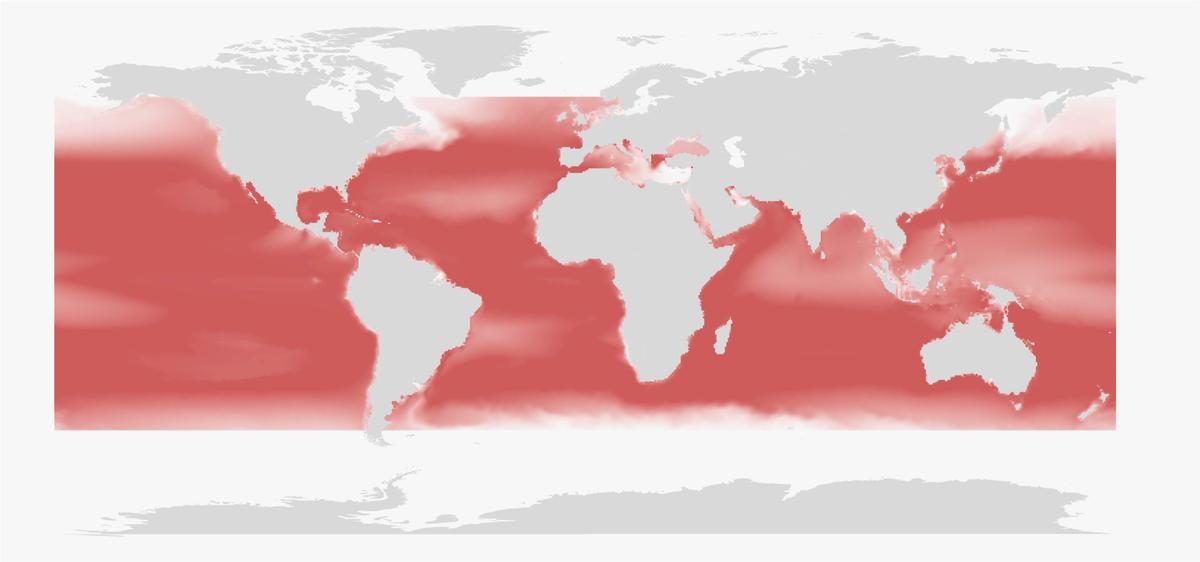
Source: Kaschner, K., Kesner-Reyes, K., Garilao, C., Segschneider, J., Rius-Barile, J. Rees, T., & Froese, R. (2019, October). AquaMaps: Predicted range maps for aquatic species. Retrieved from https://www.aquamaps.org. Scarponi, P., G. Coro, and P. Pagano. A collection of Aquamaps native layers in NetCDF format. Data in brief 17 (2018): 292-296.
Species of Binnaga (Binchou)
The following species are regarded as authentic. Either historically, according to the area of distribution or according to the common practice in today's gastronomy:
Japanese Name | Common Names, Scientific Name |
|---|---|
binnaga, abako ビンナガ、アバコ 鬢長、蜻蛉鮪 | albacore, long-fin tunny, long-finned albacore Thunnus alalunga family: Scombridae |
References & Further Reading
- [Collette & Nauen, 1983]: Bruce B. Collette, Cornelia E. Nauen. Species Catalogue, Vol. 2, Scombrids of the World. An Annotated and Illustrated Catalogue of Tunas, Mackerels, Bonitos and Related Species Known to Date, FAO Fisheries Synopsis, Vol. 2 (125). Food and Agriculture Organization of the United Nations (FAO), Rome. 1983.
- [Dhurmeea et al., 2016]: Zahirah Dhurmeea, Iker Zudaire, Emmanuel Chassot, Maria Cedras, Natacha Nikolic, Jérôme Bourjea, Wendy West, Chandani Appadoo, Nathalie Bodin. Reproductive Biology of Albacore Tuna (Thunnus alalunga) in the Western Indian Ocean. PLOS One. Source.Volume 11 (12). Public Library of Science, San Francisco. 2016.
- [FAO FishstatJ, 2020]: Fisheries and Aquaculture Department. Fishery and Aquaculture Statistics. Global production by production source 1950-2018 (FishstatJ). Food and Agriculture Organization of the United Nations (FAO), Rome. 2020. Retrieved online on December 24, 2020.
- [Farley et al., 2013]: Jessica H. Farley, Ashley J. Williams, Simon D. Hoyle, Campbell R. Davies, Simon J. Nicol. Reproductive Dynamics and Potential Annual Fecundity of South Pacific Albacore Tuna (Thunnus alalunga). PLOS One. Source.Volume 8 (4). Public Library of Science, San Francisco. 2013.
- [Froese & Daniel, 2019]: Rainer Froese, Pauly Daniel. FishBase. The Leibniz Institute of Marine Sciences at the University of Kiel, FishBase.org. 2019. https://www.fishbase.org. Retrieved online on December 24, 2020.
- [MAFF, 2019]: Ministry of Agriculture, Forestry and Fisheries (農林水産省). Sea-area Fishery Production Survey (海面漁業生産統計調査), 2018 Fisheries/Aquaculture Production Statistics (平成30年漁業・養殖業生産統計), Marine Fisheries Department (海面漁業の部), Department sea surface aquaculture (海面養殖業の部), Inland fishery aquaculture department (内水面漁業・養殖業の部). e-Stat, Government Statistical Office (政府統計の総合窓口). 2019. Retrieved online on December 24, 2020.
- [Selengut, 2018]: Becky Selengut. Good Fish: 100 Sustainable Seafood Recipes from the Pacific Coast. Sasquatch Books, Seattle. 2018.
- [Trenor, 2009]: Casson Trenor. Sustainable Sushi: A Guide to Saving the Oceans One Bite at a Time. North Atlantic Books, Berkeley. 2009.
Image Credits
City Foodsters (Grace Chen, Jason Wang). Albacore. flickr.com. License: Attribution 2.0 Generic (CC BY 2.0). Changes made: image quality, brightness, contrast, colour matching, sharpening, cropping.
TheDeliciousLife. Albacore Belly with Fried Tokyo Onions - Kiyokawa. flickr.com. License: Attribution 2.0 Generic (CC BY 2.0). Changes made: image quality, brightness, contrast, colour matching, sharpening, cropping.
takaokun. Bincho Toro Nigiri. flickr.com. License: Attribution 2.0 Generic (CC BY 2.0). Changes made: image quality, brightness, contrast, colour matching, sharpening, cropping.
